Simulating Stakeholder-Based Land-Use Change Scenarios and Their Implication on Above-Ground Carbon and Environmental Management in Northern Thailand
Abstract
:1. Introduction
2. Materials and Methods
2.1. Study Area
2.2. Scenario Development and Land-Use Change Modelling
2.2.1. Land Use Change Analysis
2.2.2. Dyna-CLUE Modelling
Calibration and Validation
Scenario-Specific Land-Use Demands and Simulated LUC Trajectories
2.3. Carbon-Stock Accounting Procedure
2.4. Sensitivity Analysis
3. Results and Discussion
3.1. Spatial and Temporal Patterns of Land Use Change during 1998–2008
3.2. Dyna-CLUE Modelling
3.2.1. Significance of Baseline Regression Coefficients and Model Validation
3.2.2. Scenario Analysis
3.3. Impacts of Land-Use Change on Above-Ground Carbon Stocks and Implications for Environmental Management
3.4. Local Stakeholders as Key Partners of Environmental Management
4. Conclusions
Supplementary Materials
Acknowledgments
Author Contributions
Conflicts of Interest
References
- Houghton, R.A.; House, J.I.; Pongratz, P.; van der Werf, G.R.; DeFries, R.S.; Hansen, M.C.; Le Quéré, C.; Ramankutty, N. Carbon emissions from land use and land-cover change. Biogeoscienes 2012, 9, 5125–5142. [Google Scholar] [CrossRef]
- Jansen, L.J.M.; Di Gregorio, A. Parametric land-cover and land-use classifications as tools for environmental change detection. Agric. Ecosyst. Environ. 2002, 91, 89–100. [Google Scholar] [CrossRef]
- Bruun, T.B.; de Neergaard, A.; Libach Burup, M.; Hepp, C.M.; Nylandsted Larsen, M.; Abel, C.; Aumtong, S.; Magid, J.; Mertz, O. Intensification of Upland Agriculture in Thailand: Development or Degradation? Land Degrad. Dev. 2016, 28, 83–94. [Google Scholar] [CrossRef]
- Ziegler, A.; Phelps, J.; Qi Yuen, J.; Webb, E.L.; Lawrence, D.; Fox, J.M.; Bruun, T.B.; Leisz, S.J.; Ryan, C.M.; Dressler, W.; et al. Carbon outcomes of major land-cover transitions in SE Asia: Great uncertainties and REDD+ policy implications. Glob. Chang. Biol. 2012, 18, 3087–3099. [Google Scholar] [CrossRef] [PubMed]
- Foley, J.A.; DeFries, R.; Asner, G.P.; Barford, C.; Bonan, G.; Carpenter, S.; Chapin, F.S.; Coe, M.T.; Daily, G.C.; Gibbs, H.K.; et al. Global consequences of land use. Sci. Total Environ. 2005, 309, 570–574. [Google Scholar] [CrossRef] [PubMed]
- UNFCCC. United Nations Framework Convention on Climate Change Outcome of the Ad Hoc Working Group on Long-term Cooperative Action under the Convention. Available online: http://unfccc.int/meetings/durban_nov_2011/meeting/6245.php (accessed on 5 April 2012).
- Bruun, T.B.; de Neergard, A.; Lawrence, D.; Ziegler, A.D. Environmental Consequences of the Demise in Swidden Cultivation in Southeast Asia: Carbon Storage and Soil Quality. Human Ecol. 2009, 37, 375–388. [Google Scholar] [CrossRef]
- Lal, R. Soil carbon sequestration to mitigate climate change. Geoderma 2004, 123, 1–22. [Google Scholar] [CrossRef]
- Fox, J.; Vogler, J.B.; Sen, O.L.; Giambelluca, T.W.; Ziegler, A.D. Simulating land-cover change in montane mainland Southeast Asia. Environ. Manag. 2012, 49, 968–979. [Google Scholar] [CrossRef] [PubMed]
- ONEP-Office of Natural Resources and Environmental Policy and Planning. Thailand’s Second National Communication under the United Nations Framework Convention on Climate Change; Ministry of Natural Resources and Environment: Bangkok, Thailand, 2010; p. 102.
- Neef, A. Fostering incentive-based policies and partnerships for integrated watershed Management in the Southeast Asian uplands. Southeast Asian Stud. 2012, 1, 247–271. [Google Scholar]
- Trébuil, G.; Ekasingh, B.; Ekasingh, M. Agricultural commercialisation, diversification, and conservation of renewable resources in northern Thailand highlands. Moussons. Recherche en Sciences Humaines sur l’Asie du Sud-Est 2006, 9–10, 131–155. [Google Scholar]
- Plieninger, T. Monitoring directions and rates of change in trees outside forests though multitemporal analysis of map sequences. Appl. Geogr. 2012, 32, 566–576. [Google Scholar] [CrossRef]
- Sumarga, E.; Hein, L. Mapping ecosystem services for land use planning, the case of Central Kalimantan. Environ. Manag. 2014, 54, 84–97. [Google Scholar] [CrossRef] [PubMed]
- Lusiana, B.; van Noordwijk, M.; Cadisch, G. Land sparing or sharing? Exploring livestock fodder options in combination with land use zoning and consequences for livelihoods and net carbon stocks using the FALLOW model. Agric. Ecosyst. Environ. 2012, 159, 145–160. [Google Scholar] [CrossRef]
- Van Noordwijk, M.; Suyamto, D.A.; Lusiana, B.; Ekadinata, A.; Hairiah, K. Facilitating agroforestation of landscapes for sustainable benefits: Tradeoffs between carbon stocks and local development benefits in Indonesia according to the FALLOW model. Agric. Ecosyst. Environ. 2008, 126, 98–112. [Google Scholar] [CrossRef]
- Anselme, B.; Bousquet, B.; Lyetc, A.; Etienne, M.; Fady, B.; LePage, C. Modelling of spatial dynamics and biodiversity conservation on Lure mountain (France). Environ. Model. Softw. 2010, 25, 1385–1398. [Google Scholar] [CrossRef]
- Lippe, M.; Thai Minh, T.; Neef, A.; Hilger, T.; Hoffmann, V.; Lam, N.T.; Cadisch, G. Building on qualitative datasets and participatory processes to simulate land use change in a mountain watershed of Northwest Vietnam. Environ. Model. Softw. 2011, 26, 1454–1466. [Google Scholar] [CrossRef]
- Verburg, P.H.; Overmars, K.P.; Huigen, M.G.A.; de Groot, W.T.; Veldkamp, A. Analysis of the effects of land use change on protected areas in the Philippines. Appl. Geogr. 2006, 26, 153–173. [Google Scholar] [CrossRef]
- Valentin, C.; Agus, F.; Alamban, R.; Boosaner, A.; Bricquet, J.P.; Chaplot, V.; de Guzman, T.; de Rouw, A.; Janeau, J.L.; Orange, D.; et al. Runoff and sediment losses from 27 upland catchments in Southeast Asia: Impact of rapid land use changes and conservation practices. Agric. Ecosyst. Environ. 2008, 124, 225–238. [Google Scholar] [CrossRef]
- Flotemersch, J.E.; Leibowitz, S.G.; Hill, R.A.; Stoddard, J.L.; Thoms, M.C.; Tharme, R.E. A watershed integrity definition and assessment approach to support strategic management of watersheds. River Res. Appl. 2016, 32, 1654–1671. [Google Scholar] [CrossRef]
- Schuler, U.; Herrmann, L.; Ingwersen, J.; Erbe, P.; Stahr, K. Comparing mapping approaches at subcatchment scale in northern Thailand with emphasis on the Maximum Likelihood approach. Catena 2010, 81, 137–171. [Google Scholar] [CrossRef]
- Fröhlich, H.; Schreinemachers, P.; Stahr, K.; Clemens, G. Policies and Innovations for Sustainable Land Use and Rural Development in Mountain Areas of Southeast Asia; Springer: Heidelberg, Germany, 2013; p. 490. [Google Scholar]
- Wünscher, T. Land Use Map of Mae Sa Mai Watershed 09/1998, Scale 1:10.000, Institute 490; University of Hohenheim: Stuttgart, Germany, 1998. [Google Scholar]
- Lillesand, T.M.; Kiefer, R.W. Remote Sensing and Image Interpretation, 4th ed.; Wiley & Sons: New York, NY, USA, 2000; p. 724. [Google Scholar]
- Aldwaik, S.Z.; Pontius, R.G. Intensity analysis to unify measurements of size and stationarity of land changes by interval, category, and transition. Landsc. Urban Plan. 2012, 106, 103–114. [Google Scholar] [CrossRef]
- Castella, J.-C.; Verburg, P.H. Combination of process-oriented and pattern-oriented models of land use change in a mountain area of Vietnam. Ecol. Model. 2007, 202, 410–420. [Google Scholar] [CrossRef]
- Trisurat, Y.; Alkemade, R.; Verburg, P.H. Projecting Land-Use Change and Its Consequences for Biodiversity in Northern Thailand. Environ. Manag. 2010, 45, 626–639. [Google Scholar] [CrossRef] [PubMed]
- Costanza, R. Model goodness of fit: A multiple resolution procedure. Ecol. Model. 1989, 47, 199–215. [Google Scholar] [CrossRef]
- Pontius, R.G.; Boersma, W.; Castella, J.-C.; Clarke, K.; de Nijs, T.; Dietzel, C.; Duan, Z.; Fotsing, E.; Goldstein, N.; Kok, K.; et al. Comparing the input, output, and validation maps for several models of land change. Annu. Reg. Sci. 2008, 42, 11–37. [Google Scholar] [CrossRef]
- Schreinemachers, P.; Potchanasin, C.; Berger, T.; Royrong, S. Agent-based assessment modeling for ex-ante assessment of tree crop innovations: Litchis in northern Thailand. Agric. Econ. 2010, 41, 519–536. [Google Scholar] [CrossRef]
- FAO. World Livestock 2011—Livestock in Food Security; FAO: Rome, Italy, 2011; p. 130. [Google Scholar]
- Hariah, K.; Dewi, S.; Agus, F.; Velarde, S.; Ekadinata, A.; Rahayu, S.; van Noordwijk, M. Measuring Carbon Stocks Across Land Use Systems: A Manual. Bogor, Indonesia; World Agroforestry Centre (ICRAF), SEA Regional Office: Nairobi, Kenya, 2011; p. 154. [Google Scholar]
- Yang, X.; Blagodatsky, S.; Lippe, M.; Liu, F.; Hammon, J.; Xu, J.; Cadisch, G. Land-use change impact on time-averaged carbon balances: Rubber expansion and reforestation in a biosphere reserve, South-West China. For. Ecol. Manag. 2016, 372, 149–163. [Google Scholar] [CrossRef]
- PCRaster. Available online: http://www.pcraster.geo.uu.nl (accessed on 18 August 2012).
- Thomas, D.; Preechapanya, P.; Saipothong, P. Landscape Agroforestry in Upper Tributary Watersheds of Northern Thailand. J. Agric. 2002, 18, 1–36. [Google Scholar]
- Matsumoto, N.; Paisancharoen, K.; Hakamata, T. Carbon balance in maize fields under cattle manure application and no-tillage cultivation in Northeast Thailand. Soil Sci. Tillage 2008, 54, 277–288. [Google Scholar] [CrossRef]
- Fukushima, M.; Kanzaki, M.; Hara, M.; Ohkubo, T.; Preechapanya, P.; Choocharon, C. Secondary forest succession after the cessation of swidden cultivation in the montane forest area in Northern Thailand. For. Ecol. Manag. 2008, 225, 1994–2006. [Google Scholar] [CrossRef]
- Kaewkron, P.; Kaewkla, N.; Thummikkapong, S.; Punsang, S. Evaluation of carbon storage in soil and plant biomass of primary and secondary mixed deciduous forests in the lower northern part of Thailand. Afr. J. Environ. Sci. Technol. 2011, 5, 8–14. [Google Scholar]
- Terakunpisut, J.; Gajaseni, N.; Ruankawe, N. Carbon sequestration potential in above-ground biomass of Thong Pha Phum National Forest, Thailand. Appl. Ecol. Environ. Res. 2007, 5, 93–102. [Google Scholar] [CrossRef]
- Petsri, S.; Pumijumnong, N. Above-ground carbon content in mixed deciduous forest and teak plantations. Environ. Nat. Resour. 2007, 5, 1–10. [Google Scholar]
- Gnanavelrajah, N.; Shresta, R.P.; Schmidt-Vogt, D.; Samarakoon, L. Carbon stock assessment and soil carbon management in agricultural land-uses in Thailand. Land Degrad. Dev. 2008, 19, 242–256. [Google Scholar] [CrossRef]
- Fox, J.; Vogler, J.B. Land-Use and Land-Cover Change in Montane Mainland Southeast Asia. Environ. Manag. 2005, 36, 394–403. [Google Scholar] [CrossRef] [PubMed]
- Hares, M. Forest conflict in Thailand: Northern minorities in focus. Environ. Manag. 2009, 43, 381–395. [Google Scholar] [CrossRef] [PubMed]
- Vanwambeke, S.O.; Somboon, P.; Lambin, E.F. Rural transformation and land use change in northern Thailand. Land Use Sci. 2008, 2, 1–29. [Google Scholar] [CrossRef]
- Lippe, R.S.; Seebens, H.; Isvilanonda, S. Urban Household Demand for Fresh Fruits and Vegetables in Thailand. Appl. Econ. J. 2010, 17, 1–26. [Google Scholar]
- Ardli, E.R.; Wolff, M. Land use and land cover change affecting habitat distribution in the Segara Anakan lagoon, Java, Indonesia. Reg. Environ. Chang. 2008, 9, 235–243. [Google Scholar] [CrossRef]
- Lusiana, B.; Suyamto, D.A.; van Noordwijk, M.; Mulia, R.; Joshi, L.; Cadisch, G. User’s perspective on validity of a simulation model for natural resource management. Int. J. Agric. Sustain. 2011, 9, 364–378. [Google Scholar]
- Verburg, P.H. Simulating feedbacks in land use and land cover change models. Landsc. Ecol. 2006, 21, 1171–1183. [Google Scholar] [CrossRef]
- Yap, V.Y.; de Neergaard, A.; Bruun, T.B. “To adopt or not to adopt?” Legume adoption in maize-based systems of Northern Thailand: Constraints and potential. Land Degrad. Dev. 2017, 28, 731–741. [Google Scholar] [CrossRef]
- Becknell, J.M.; Kissing Kucek, L.; Powers, J.S. Aboveground biomass in mature and secondary seasonally dry tropical forests: A literature review and global synthesis. For. Ecol. Manag. 2012, 276, 88–95. [Google Scholar] [CrossRef]
- Palm, C.A.; Woomer, P.L.; Alegree, J.; Arevaldo, L.; Castilla, C.; Cordeiro, D.G.; Feigl, B.; Hariah, K.; Kotto-Same, J.; Mendes, A.; et al. Carbon Sequestration and Trace Gas Emissions in Slash-and-Burn and Alternative Land-Uses in the Humid Tropics; Final Report, Phase II, (TSBF); ASB Climate Change Working Group: Nairobi, Kenya, 2000. [Google Scholar]
- Laosuwan, T.; Utturak, P. Review of methods and potential role of remote sensing forest carbon stock measurement: A pilot project for REDD+ in Thailand. Int. J. Geoinform. 2013, 9, 39–48. [Google Scholar]
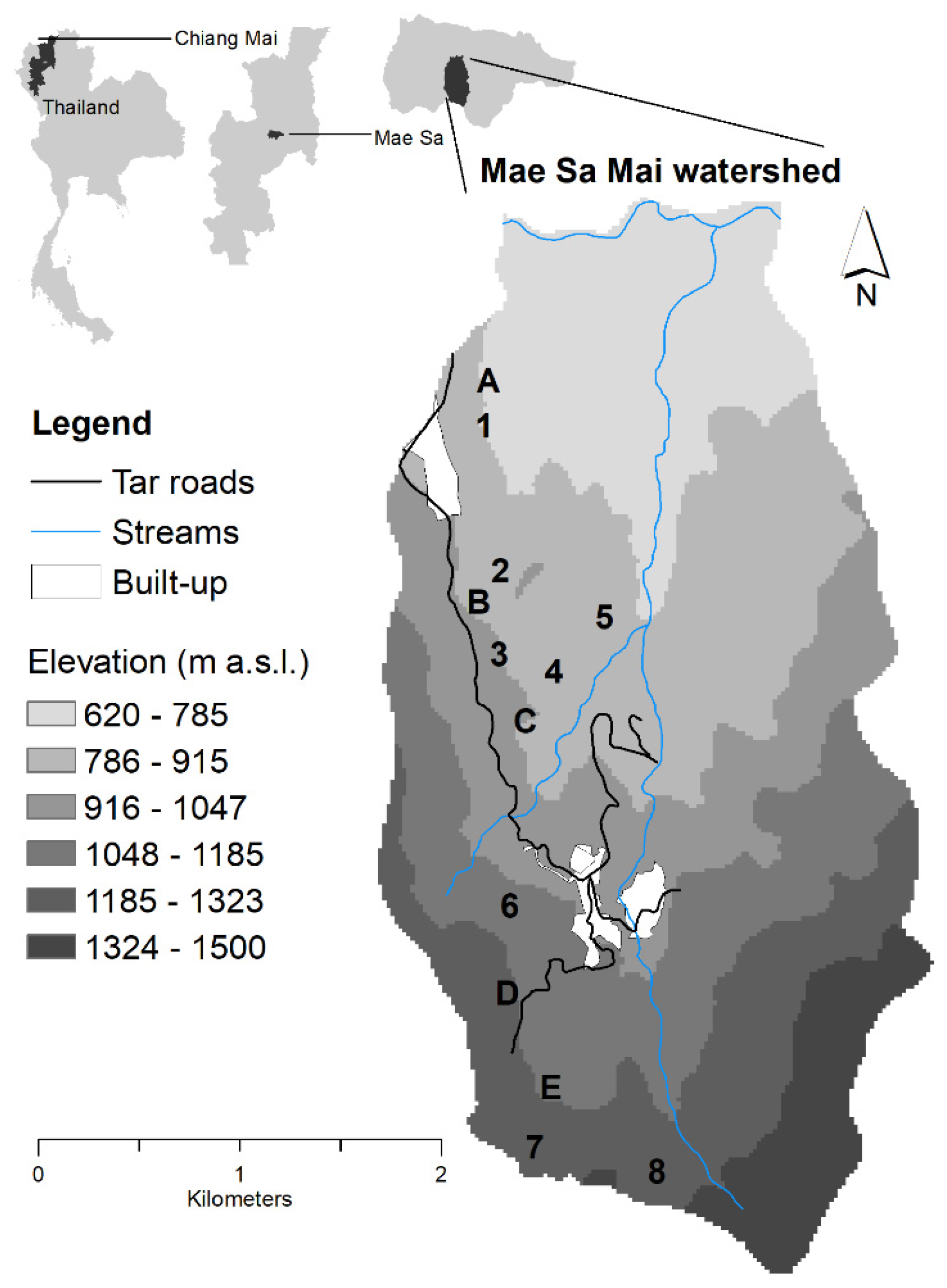
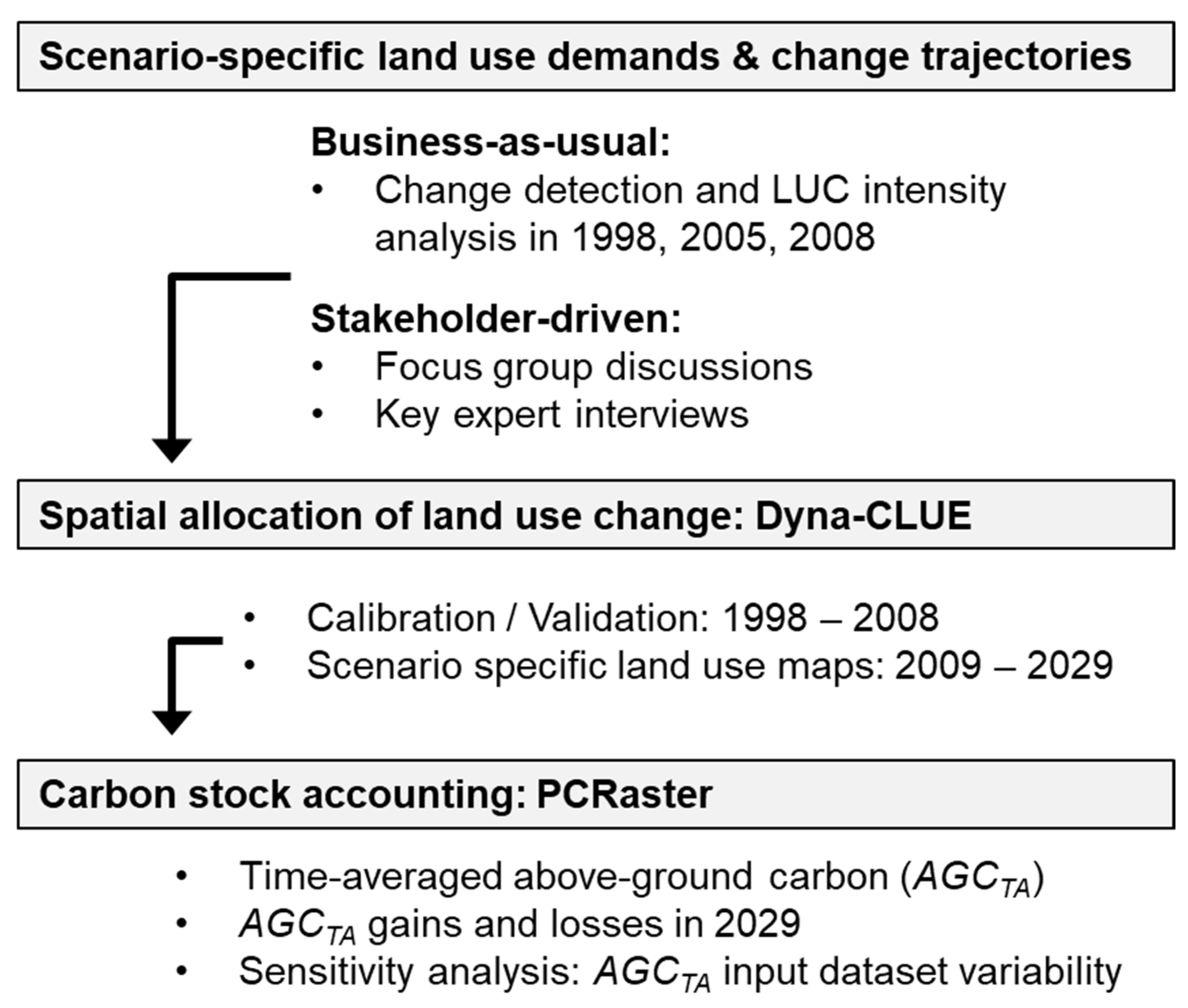
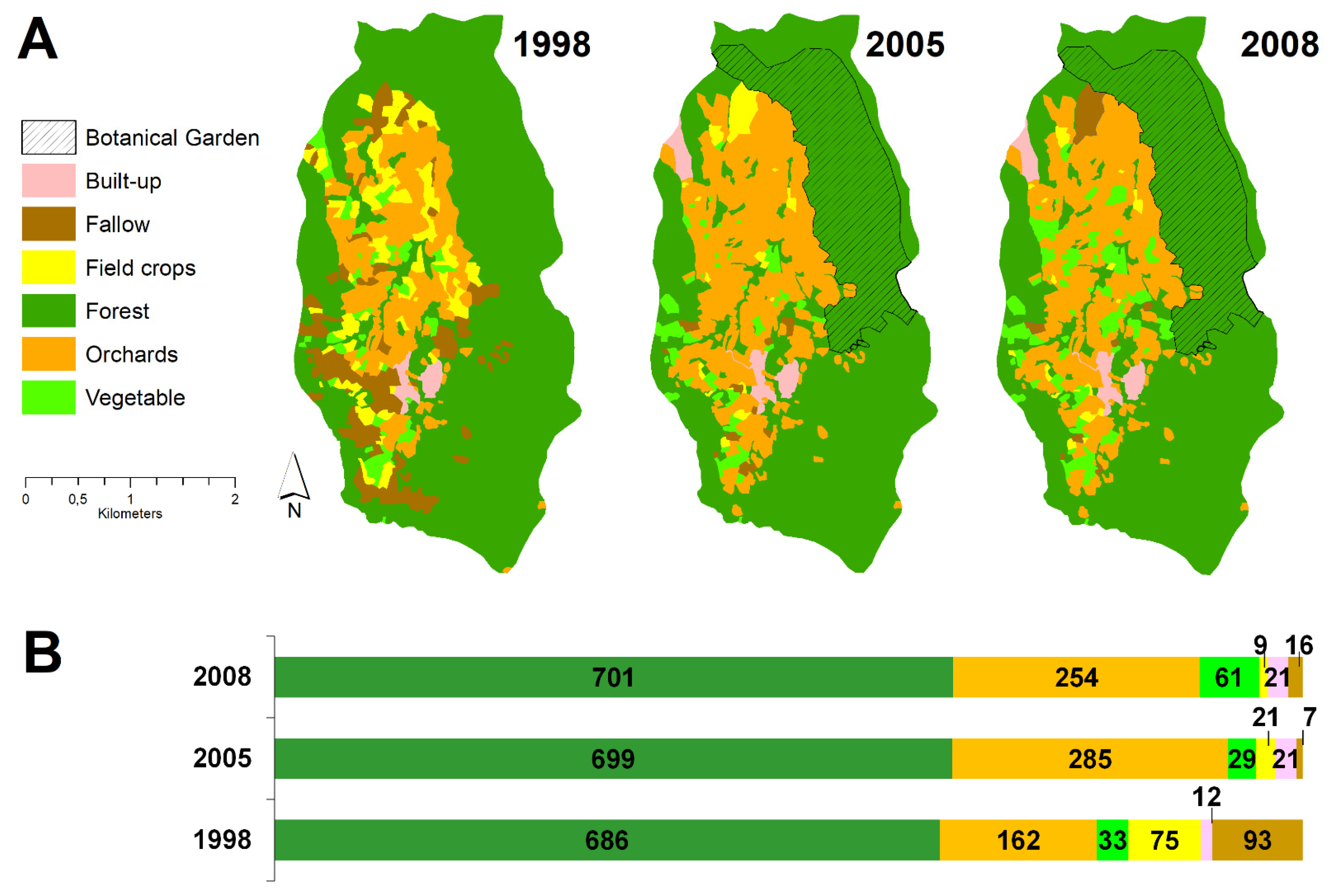
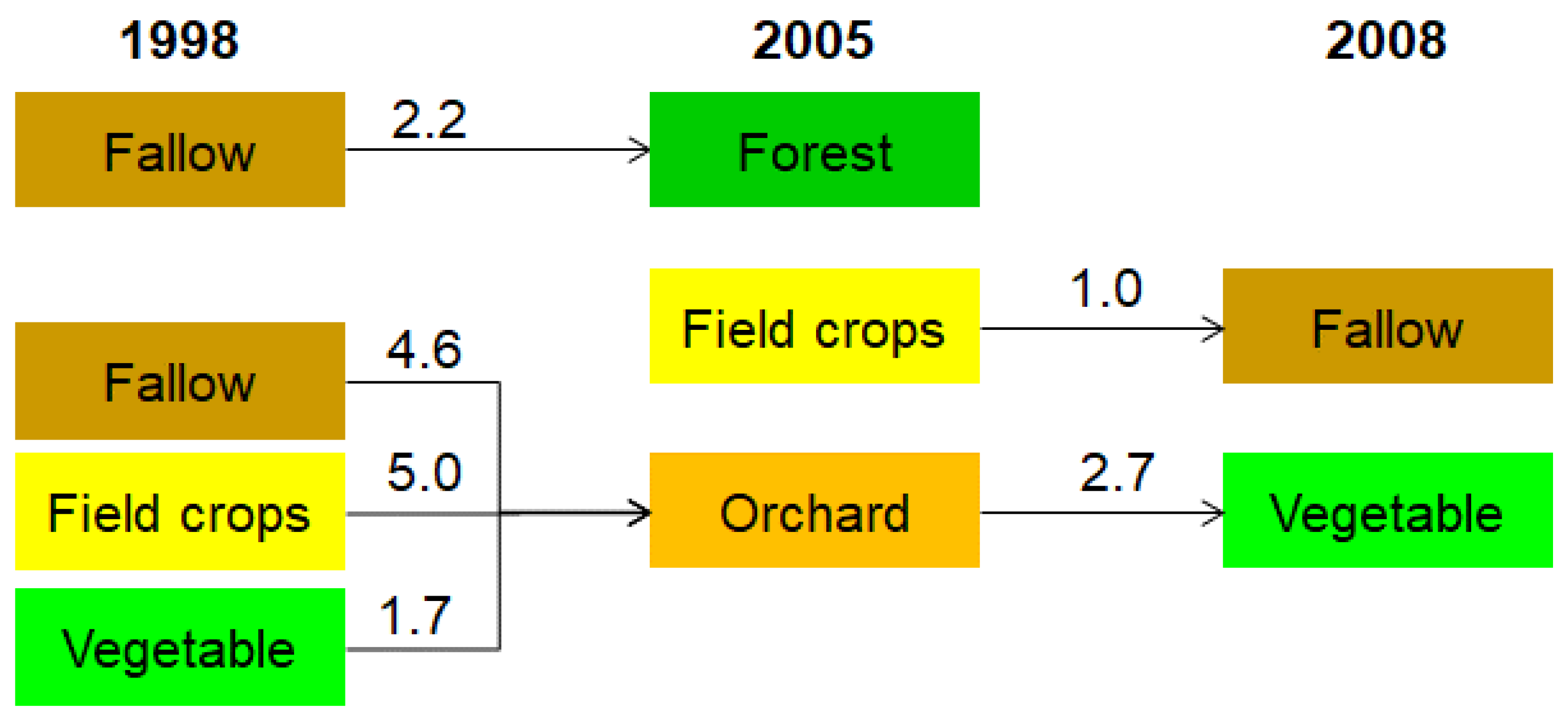
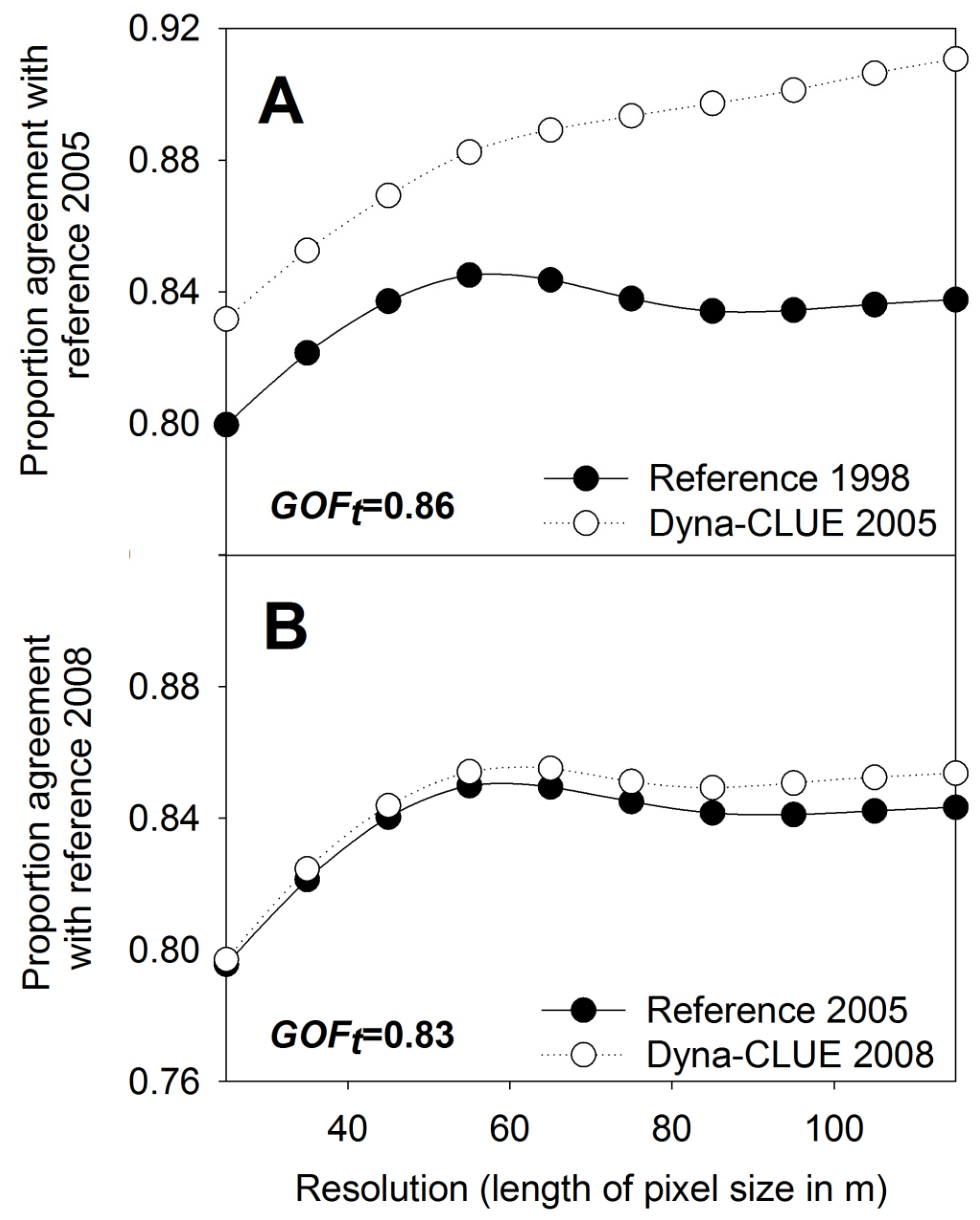
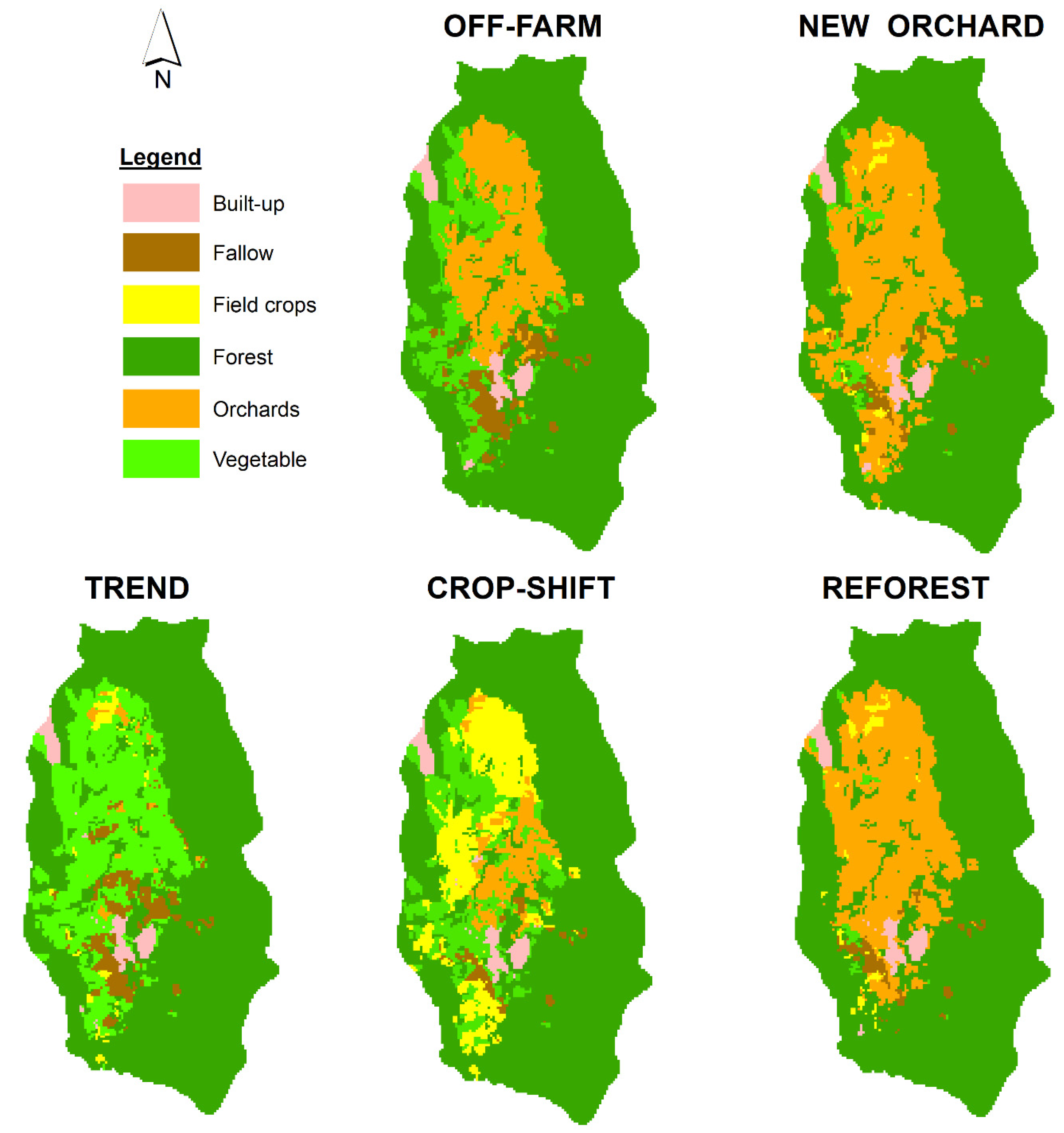
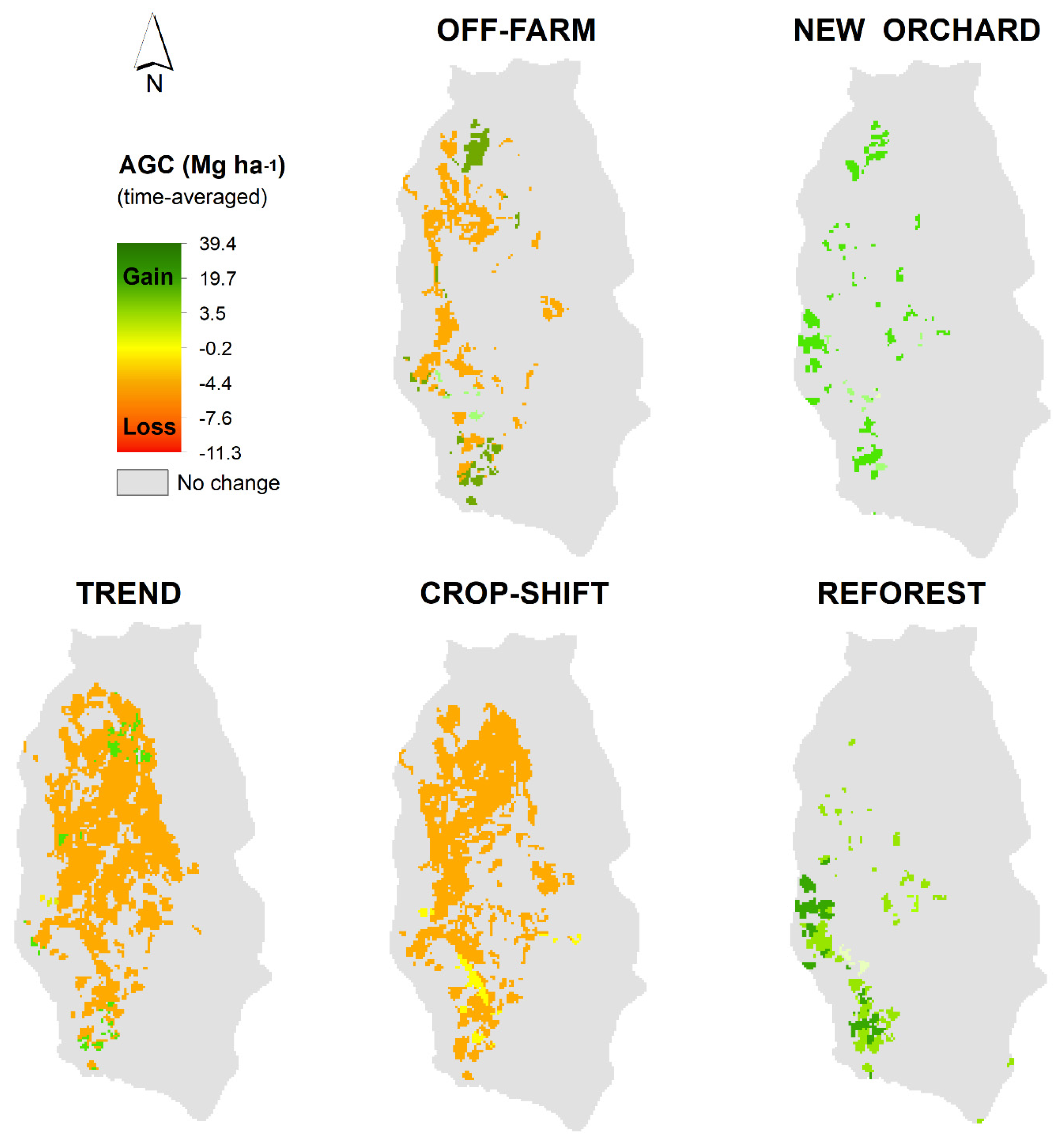
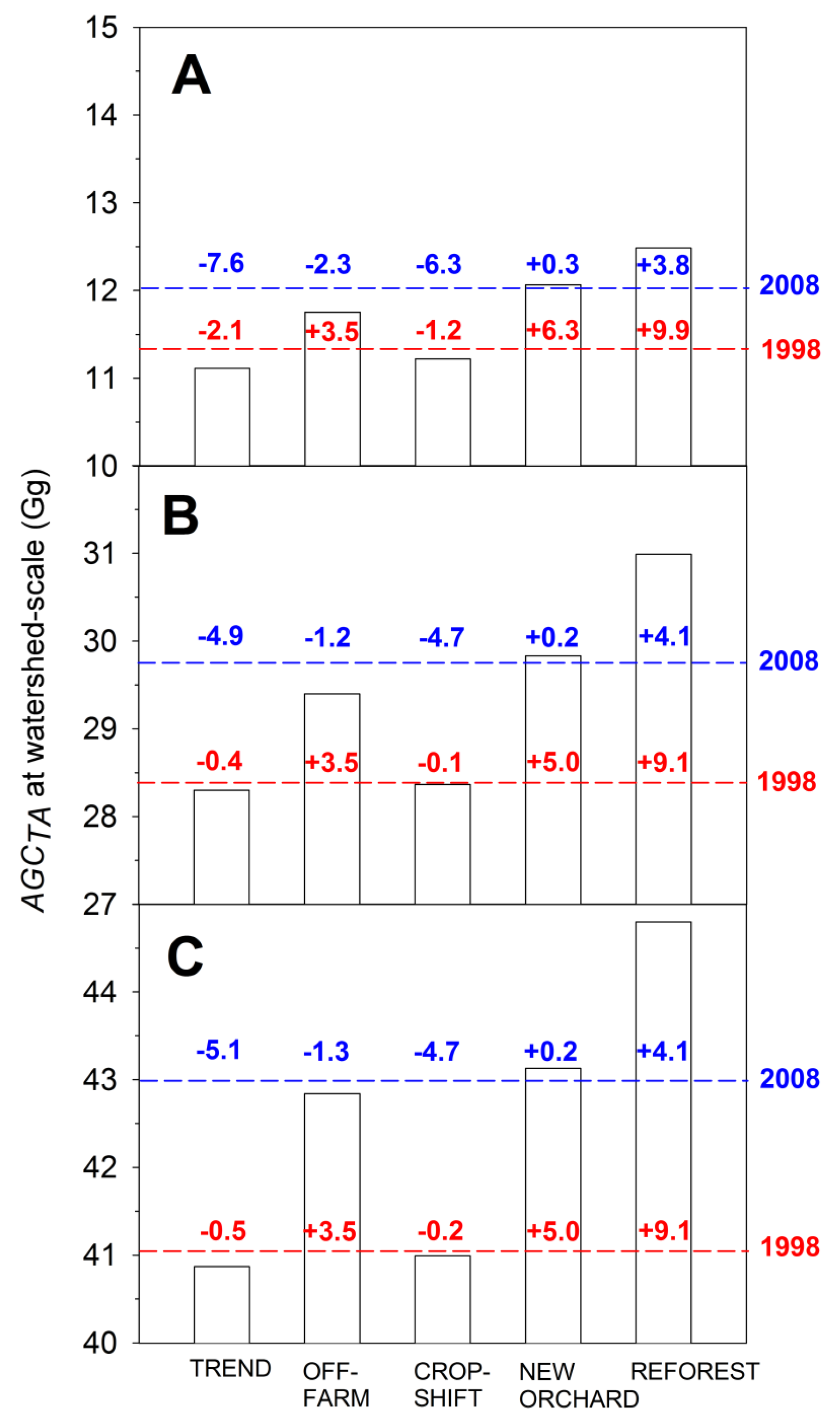
| Land Use Type | Description |
|---|---|
| Built-up | Settlement areas or buildings, i.e., royal project field station |
| Fallow | Short to intermediate fallow stages (<3 years), predominantly composed of grass and bushy vegetation |
| Field crops | Maize (Zea mays), paddy and upland rice (Oriza sativa) |
| Orchards | Litchi chinensis, Persimon spp. and Musa spp. |
| Vegetables | Brassica spp. (i.e., common cabbage); leafy vegetables and others, (i.e., lettuce and carrots) |
| Forests | Degraded deciduous and dry evergreen forest types, with small reforestation patches of Pinus spp. |
| Scenario | Storyline Description a | Based on | LUC Trajectories b |
|---|---|---|---|
| TREND | Continue LUC trends 2006–2008 to 2029. | Change detection analysis | OR → FA, VE |
| OFF-FARM | LUC trajectory ‘Orchard to Vegetables/Fallow’ decreases related land-use demand by 25% compared to TREND due to increasing off-farm working opportunities and abandonment of farming activities | Focus group discussion | OR → FA, VE |
| CROP-SHIFT | Cash-crop shift from vegetables to maize-based cropping systems induced by regional demands for livestock feeds. Conversion rate of orchards-to-vegetables/fallow 10% lower then TREND | Focus group discussion | OR → FC, VE |
| NEW ORCHARD | Fruit tree plantations (Persimon spp.) replace fallow, field crops and vegetable fields by 2 ha per year; other LUC trajectories are no longer active | Key informant interviews c | FA, FC, VE → OR |
| REFOREST | Reforestation with local tree species replaces fallow and vegetable fields by 2 ha per year; other LUC trajectories are no longer active | Key informant interviews d | FC, FA, VE → SF |
| Land Use # | AGCTA | AGCMAX | AGCINC | TR | Reference | ||||||||
|---|---|---|---|---|---|---|---|---|---|---|---|---|---|
| avg | min | max | avg | min | max | avg | min | max | avg | min | max | ||
| (Mg ha−1) | (Mg ha−1 a−1) | (years) | |||||||||||
| Fallow | 1.0 | 0.6 | 1.5 | 3.0 | 1.8 | 4.5 | 1.0 | 0.6 | 1.5 | 3 | 3 | 3 | [7,36] |
| Field crops | 0.7 | 0.3 | 1.4 | 1.4 | 0.5 | 2.7 | 0.5 | 0.3 | 0.9 | 1 | 1 | 1 | [7,37] |
| Orchards | 7.7 | 4.4 | 11.3 | 15.3 | 8.8 | 22.6 | 0.7 | 4.4 | 11.3 | 22 | 10 | 33 | own survey (n = 8) |
| Vegetables | 0.3 | 0.1 | 0.4 | 0.5 | 0.3 | 0.8 | 0.3 | 0.2 | 0.4 | 1 | 1 | 1 | own survey (n = 5) |
| Secondary forests | 39.4 | 15.4 | 56.9 | 78.8 | 30.7 | 113.8 | 1.6 | 0.6 | 2.3 | 50 | 39 | 68 | [4,7,36,38,39,40,41,42] |
© 2017 by the authors. Licensee MDPI, Basel, Switzerland. This article is an open access article distributed under the terms and conditions of the Creative Commons Attribution (CC BY) license (http://creativecommons.org/licenses/by/4.0/).
Share and Cite
Lippe, M.; Hilger, T.; Sudchalee, S.; Wechpibal, N.; Jintrawet, A.; Cadisch, G. Simulating Stakeholder-Based Land-Use Change Scenarios and Their Implication on Above-Ground Carbon and Environmental Management in Northern Thailand. Land 2017, 6, 85. https://doi.org/10.3390/land6040085
Lippe M, Hilger T, Sudchalee S, Wechpibal N, Jintrawet A, Cadisch G. Simulating Stakeholder-Based Land-Use Change Scenarios and Their Implication on Above-Ground Carbon and Environmental Management in Northern Thailand. Land. 2017; 6(4):85. https://doi.org/10.3390/land6040085
Chicago/Turabian StyleLippe, Melvin, Thomas Hilger, Sureeporn Sudchalee, Naruthep Wechpibal, Attachai Jintrawet, and Georg Cadisch. 2017. "Simulating Stakeholder-Based Land-Use Change Scenarios and Their Implication on Above-Ground Carbon and Environmental Management in Northern Thailand" Land 6, no. 4: 85. https://doi.org/10.3390/land6040085





